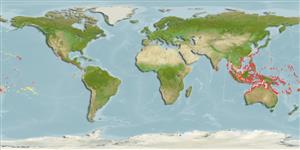>
Ovalentaria/misc (Various families in series Ovalentaria) >
Pseudochromidae (Dottybacks) > Pseudochrominae
Etymology: Pseudochromis: Greek, pseudes = false + Greek, chromis = a fish, perhaps a perch (Ref. 45335).
More on author: Bleeker.
Environment: milieu / climate zone / depth range / distribution range
Ecologie
marien rifbewoner; diepte 0 - 30 m (Ref. 37816), usually 0 - 20 m (Ref. 27115). Tropical; 30°N - 24°S
Western Pacific: Peninsular Malaysia to Hong Kong and the Ryukyu Islands, south to Western Australia, and east to Vanuatu and the Gilbert Islands. Replaced by an undescribed species at Fiji and Tonga and Pseudochromis coccinicauda in the Indian Ocean (Ref. 37816).
Grootte / Gewicht / Leeftijd
Maturity: Lm ? range ? - ? cm
Max length : 6.2 cm TL mannelijk / geslacht onbekend; (Ref. 90102)
Dorsale stekels (totaal): 3; Dorsale zachte stralen (totaal): 21-23; Anale stekels 3; Anale zachte stralen: 12 - 14. Females sexually dichromatic dottyback are uniformly grey, sometimes becoming yellowish or reddish on the tail (Ref. 37816).
A common but secretive species (Ref. 9710, 48635) found in holes and crevices of exposed outer reef flats and reef margins. Occurs in pairs and feeds on small crabs, isopods, and copepods (Ref. 1602). Usually most abundant in high current or surge areas. Frequently enters the aquarium fish trade and has been bred in captivity (Ref. 37748). Sometimes solitary (Ref 90102).
Levenscyclus en paargedrag
Maturiteit | Voortplanting | Paaien | Eieren | Fecunditeit | Larven
Bi-directional sex change has been confirmed for this species (Ref. 103751).
Myers, R.F., 1991. Micronesian reef fishes. Second Ed. Coral Graphics, Barrigada, Guam. 298 p. (Ref. 1602)
Status op de Rode Lijst van het IUCN (Ref. 130435)
Gevaar voor de mens
Harmless
Gebruik door de mens
Aquarium: Commercieel
Meer informatie
ReferentiesAquacultuurAquacultuurprofielKweeklijnenGeneticaElectrophoresesErfelijkheidZiektesVerwerkingNutrientsMassaconversie
Tools
Speciale rapporten
Download XML
Internetbronnen
Estimates based on models
Preferred temperature (Ref.
123201): 25.1 - 29, mean 27.9 °C (based on 648 cells).
Fylogenetische diversiteitsindex (Ref.
82804): PD
50 = 0.5000 [Uniqueness, from 0.5 = low to 2.0 = high].
Bayesian length-weight: a=0.00490 (0.00187 - 0.01281), b=3.11 (2.88 - 3.34), in cm total length, based on LWR estimates for this (Sub)family-body shape (Ref.
93245).
Trofisch niveau (Ref.
69278): 3.3 ±0.44 se; based on food items.
Fishing Vulnerability (Ref.
59153): Low vulnerability (10 of 100).
Nutrients (Ref.
124155): Calcium = 200 [100, 344] mg/100g; Iron = 0.952 [0.548, 1.633] mg/100g; Protein = 18.3 [17.1, 19.3] %; Omega3 = 0.111 [0.061, 0.202] g/100g; Selenium = 26 [11, 58] μg/100g; VitaminA = 142 [43, 447] μg/100g; Zinc = 2.39 [1.54, 3.48] mg/100g (wet weight);
